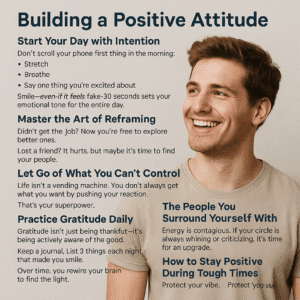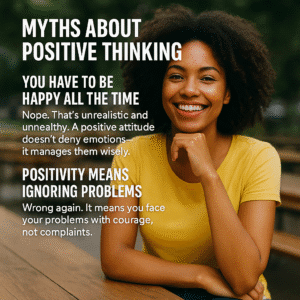Introduction
Have you ever met someone whose energy lights up the whole room the moment they walk in? What captivates everyone isn’t their looks or bank balance—it’s the vibrant positivity they radiate. And here’s the truth: you can be that person too. Having a positive attitude doesn’t mean you turn a blind eye to life’s challenges or act like everything is flawless. It’s about choosing your response in a way that empowers you. It’s about choosing growth over fear, gratitude over grumbling, and solutions over complaints.
Understanding the Core of Positivity
Positive Attitude vs. Toxic Positivity
Let’s clear something up. Toxic positivity is fake-smiling through pain. A true positive attitude is acknowledging the pain but still choosing to move forward. It’s the difference between “Everything’s fine!” and “Things are tough, but I’ll get through this.”
How Your Mindset Shapes Your Reality
Your mind is like a lens. If it’s cracked with negativity, everything looks broken. But when you clean that lens with optimism, suddenly opportunities appear, even in chaos. What you focus on grows.
Science Behind Staying Positive
● Studies show that positivity:
● Boosts immunity
● Reduces stress
● Increases life span
● Improves problem-solving abilities
Dr. Barbara Fredrickson’s “Broaden and Build” theory proves that positive emotions expand our capacity to think clearly and build lasting resources.
 The Real Benefits of a Positive Attitude
The Real Benefits of a Positive Attitude
Mental Health Improvements
Positivity serves as a protective barrier, helping to fend off anxiety, depression, and emotional
exhaustion.
Physical Health Benefits
A happier outlook improves:
● Heart health
● Immune system function
● Pain tolerance Optimists literally heal faster and live longer. That’s wild, right?
Better Relationships
Positive people attract others like magnets. Why? Because they listen better, complain less, and
make others feel valued.
Enhanced Productivity and Success
People who embrace a growth mindset treat challenges as stepping stones for development and self-improvement.
They don’t stall at “I can’t.” Instead, they ask, “How can I?” That’s a game-changer in careers and entrepreneurship.
 Building a Positive Attitude (SStep-by-Step
Building a Positive Attitude (SStep-by-Step
Start Your Day with Intention
Don’t scroll your phone first thing in the morning. Instead:
● Stretch
● Breathe
● Say one thing you’re excited about
● Smile—even if it feels fake
That 30 seconds sets your emotional tone for the entire day.
Master the Art of Reframing
Didn’t get the job? Now you’re free to explore better ones.
Lost a friend? It hurts, but maybe it’s time to find your people.
Reframing isn’t lying—it’s choosing a stronger narrative.
Let Go of What You Can’t Control
Life isn’t a vending machine. You don’t always get what you want by pushing buttons. But you do control your reaction. That’s your superpower.
Practice Gratitude Daily
Gratitude isn’t just being thankful—it’s being actively aware of the good. Keep a journal. List 3 things each night that made you smile. Over time, you rewire your brain to find the light.
Daily Habits That Fuel Positivity
Journaling Thoughts and Wins
When you write down your daily wins, no matter how small, you train your brain to seek
progress instead of perfection.
Journaling Thoughts and Wins
“I am enough.”
“I handle challenges with grace.”
Speak it. Write it. Believe it. Repetition changes your inner voice.
The People You Surround Yourself With
Energy is contagious. If your circle is always whining or criticizing, it’s time for an upgrade.
Protect your vibe.
How to Stay Positive During Tough Times
Turning Setbacks Into Setups
Every “failure” is feedback. Didn’t work out? Now you know what to fix.
Pain can become one of life’s greatest teachers—if you’re open to learning from it.
Finding the Lesson in Every Loss
Lost something or someone? Don’t ask, “Why me?” Ask, “What is this teaching me?” That shift creates meaning, not misery.
Dealing with Negative People
Not everyone’s going to be sunshine. However, you aren’t required to take on their emotional turmoil.
Set boundaries. Don’t argue—just guard your peace.
 Myths About Positive Thinking
Myths About Positive Thinking
You Have to Be Happy All the Time
Nope. That’s unrealistic and unhealthy. A positive attitude doesn’t deny emotions—it manages them wisely.
Positivity Means Ignoring Problems
Wrong again. It means you face your problems with courage, not complaints.
Long-Term Impact of Positive Attitude
Career Growth and Leadership
Optimistic leaders inspire loyalty. They build teams, not armies. To inspire others to follow you, you must have faith in both the purpose and the people involved.
Emotional Resilience
When life hits hard, positive people bend but don’t break. They cry, sure—but they also rise. Every. Single. Time.
Legacy and Influence
Your attitude is what people remember. Years later, they may forget your words, but they’ll never forget how you made them feel.
Conclusion
Positivity isn’t about being delusional—it’s about being intentional. It’s a conscious choice to lead with love, light, and possibility. It’s choosing to see the sunrise behind every storm. The next time life surprises you with a challenge, greet it with a smile and say,
“Alright, life, show me what you’ve got.”
FAQs

1. What are the signs of a positive attitude?
Smiling often, focusing on solutions, being grateful, handling criticism gracefully, and inspiring
Others are all signs.
2. Can a positive attitude be developed later in life?
Definitely. Thanks to neuroplasticity, your brain can adapt and grow no matter how old you are.
3. How can I stay positive in a negative environment?
Protect your energy, set boundaries, use affirmations, and limit exposure to toxic influences.
4. What role does self-talk play in positivity?
Self-talk is the foundation. Negative self-talk can destroy your mood; positive self-talk can lift you out of dark places.
5. Is being positive the same as being optimistic?
Not quite. Positivity is your attitude, optimism is your expectation. You can have one without the other—but together, they’re unstoppable.

